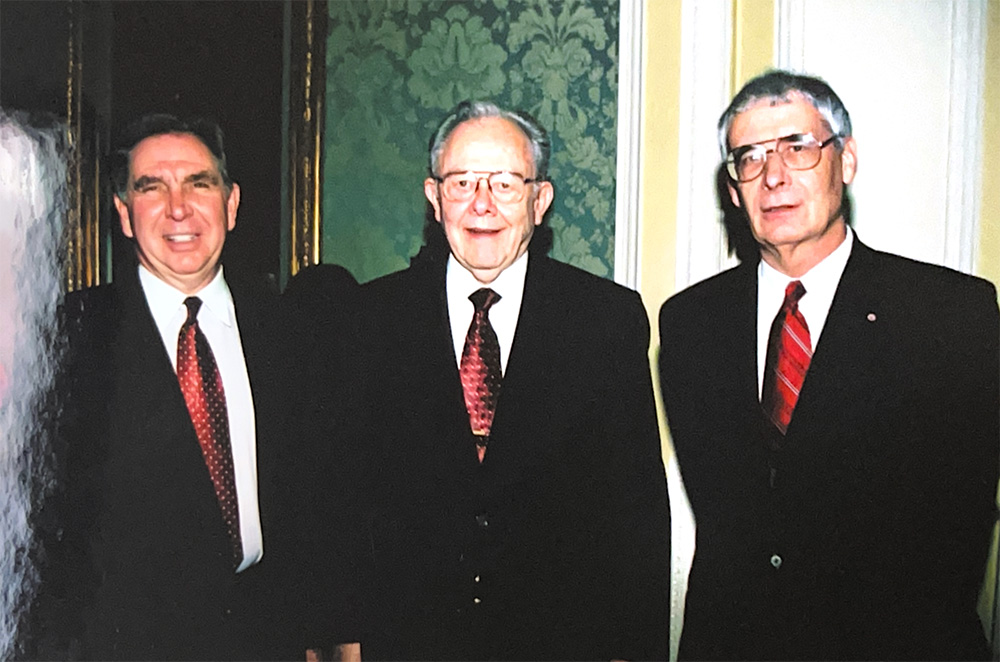
Chemistry Faculty News in the Spring 2007 Alumni Newsletter
Distinguished Prof. David M. Grant was honored Sept. 8, 2006 by having the Gauss Haus named after him.

Earlier in 2006 a special issue of Magnetic Resonance in Chemistry (Vol. 44, #3) was published honoring Dr. Grant on his 75th birthday and celebrating his many contributions to the methodology and applications of Carbon-13 Nuclear Magnetic Resonance spectroscopy. Building a great Chemistry Department is very much a community enterprise, but a strong case can be made for identifying David M. Grant as the one person who did the most to bring the Department from obscurity to true prominence.
Dr. Valeria Molinero (Ph.D. 1999, University of Buenos Aires) joined the Chemistry faculty on August 16, 2006 as an Assistant Professor. She uses powerful computational methods to model the transformation between amorphous phases and crystalline matter, teaches physical chemistry, and is making an excellent reputation for herself with path-breaking publications.
Dr. Jon Rainier was promoted to the rank of Full Professor.
Dr. John Conboy was promoted to Associate Professor with Tenure.
Dr. Janis Louie was promoted to Associate Professor with Tenure.
Henry White was elected to the rank of Distinguished Professor by other Distinguished Professors. With the approval of the central administration, College of Science Dean Pierre Sokolsky selected Distinguished Professor Henry White to be Chair of the Chemistry Department beginning July 1, 2007, following Peter B. Armentrout.
The casual reader of this history may be interested to know that the Chair of a department at the University is not required to be a Full or Distinguished Professor. David M. Grant began Chairing the Chemistry Department when he was a young Associate Professor. What a Chair must have is exemplary leadership qualities. There is no room in a first rate university for a Chair who “leads from behind.”
The jump in academic rank from Assistant to Associate Professor with “Tenure” at the University of Utah is very important because the “winner” after no more than seven years of “involuntary servitude” does not need to search immediately for some other paid employment. Over the past fifty years fewer than fifteen percent of the young people joining the Utah Chemistry faculty have been denied promotion with tenure. However, it should be noted that “Tenure” does not guarantee employment until age 65 or later. If a “tenured” faculty member frequently fails to teach her/his assigned classes acceptably or does not perform faithfully other assigned duties such as committee work, counseling of students, participating in oral examinations of degree candidates, etc., she or he may be fired for cause after review by the central university administration.
Back now to the happy success stories of the Chemistry faculty reported in the Spring 2007 Alumni Newsletter:
Prof. Joel Miller was selected to appear on Thomsen Scientific’s ISIHighlyCited.com because of his “exceptional citation count in the field of Material Science.”
High School student Lindsay Hubley drew favorable attention to the research lab of Prof. Sheila David by winning Third Place at the 2006 International Science and Engineering Fair in Indianapolis.
TITLE IX ISSUES
On September 19, 2006, Prof. Richard Zare of Stanford University delivered the Cal Giddings Lecture on “Making It Count: Quantitation of Low-Copy-Number Proteins in Single Cells.” That Spring he had written an article [Chemical & Engineering News, May 15, 2006, pp. 46-49] about ways to grow the participation of women in U.S. academic chemistry. Zare recommended collecting several “Title IX measurables” annually. In the Spring 2007 Chemistry Alumni Newsletter his “measurables” are listed with the performance for academic year 2005-2006 by the Utah Chemistry Department shown in parentheses:
Percentage of undergrads. majoring in chem who are women (102/277 or 37%)
Percentage of grad. students in chem. who are women (71/164 or 43%)
Percentage of postdocs. in chem. who are women (7/46 or 15%)
Percentage of lecturers/instructors in chem. who are women (1/3 or 33%)
Percentage of assistant professors in chem. who are women (2/5 or 40%)
Percentage of associate professors in chem. who are women (1/4 or 25%)
Percentage of full professors in chem. who are women (2/22 or 9%)
Thus among our younger faculty (assistant and associate professors), 30% were women.
On June 19, 2007, Distinguished Professor Cheves T. Walling (1916-2007) passed away peacefully in Peterborough, New Hampshire. He had a tremendous favorable impact on the reputation of Chemistry at Utah before becoming an Emeritus Professor in 1991.
On July 25, 2008, Dr. H. Tracy Hall, the “father” of manmade industrial diamonds, passed away in Provo, Utah. He was Henry Eyring’s first Ph.D. student, graduating from the University of Utah in 1948. Tracy became Director of Research at BYU-Provo in 1955 and fathered many diamond producing companies world-wide as well as in Utah.
The Spring National Meeting of the American Chemical Society was held in Salt Lake City for the very first time during the interval March 22-26, 2009. The Utah Chemistry Department was well represented at this meeting by students and faculty of the department delivering technical talks to the meeting attendees. Dr. Jan Hayes, the Chair of the ACS Division of History of Chemistry at the time, had secured funding for a half day symposium honoring the legacy of the late Henry Eyring. Invited speakers included Prof. Douglas Henderson (BYU-Provo), Prof. Josef Michl (Univ. of Colorado, Boulder), Prof. Dan Urry (Univ. of Minnesota and University of Alabama, Birmingham) and Prof. (Steven Kuznicki (University of Alberta, Edmonton). One of the highlights of the symposium was a graphic prepared by Dr. Amy Dambromovitz (University of Alberta) showing that Henry Eyring’s 700+ scientific papers continue to generate citations in the scientific literature at a high level even thirty plus years after his death.
